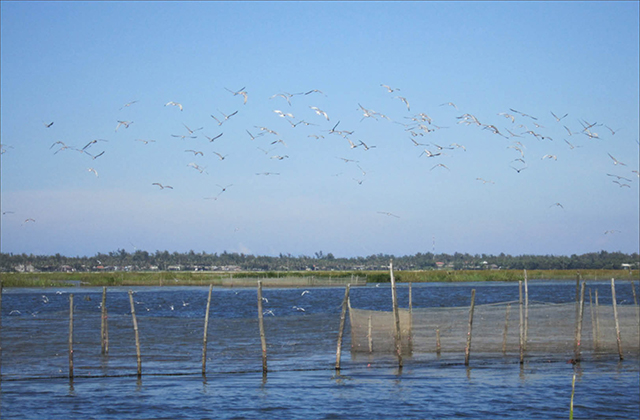
One of the typical species of bird in Cau Hai Lagoon
Diversity
Tam Giang - Cau Hai Lagoon includes 7 types of wetland: seagrass, intertidal zone, mangrove forest; estuary, coastal lagoon, pond, lake, lagoon for aquaculture and agricultural land.
According to the Institute of Strategy and Policy on Natural Resources and Environment, when the Institute of Natural Resources and Environment conducted the survey to build Tam Giang - Cau Hai Wetland Reserve, they found that there were up to 1,296 species in the lagoon system, belonging to different groups: plants (higher order, plankton, seaweed and plants, aquatic plants), birds, reptiles, amphibians, fish, plankton, mollusks, crustaceans, silkworms.
It is the ecological diversity of wetland, together with the complicated change in environment that result in the diversity of creatures in the area.
According to fishermen at the lagoon, in recent years, some endemic shrimp and fish species have been found again in the lagoons and estuaries. Some species are quite abundant such as gobies, spade fish, bees, shrimps, crabs, etc. Abundant seaweed in some lagoons gives rise to the recovery and proliferation of other aquatic animals and plants.
Although there is the recovery of some species, the wetland area is currently affected by economic activities of the local community such as aquaculture, fishing, tourism, cattle and poultry husbandry, industry and handcraft, and constructions such as dams, ports and the climate change.

O Lau Estuary is where there are many migrant birds.
According to experts of the Institute of Strategy and Policy on Natural Resources and Environment, there have been many changes since the beginning of the project such as the appearance of sea turtles, the decrease in number of birds, and the thrive of alien species such as yellow snails, water hyacinths, mimosa pigra.
Adjustment
The establishment of Tam Giang-Cau Hai Wetland Reserve is expected to be done in two phases. Phase 1 (2019-2020) covers an area of 2,033.8ha in which the strictly protected subdivision is 813.3ha, the ecological restoration subdivision is 1,203.4ha and the subdivision for administration and services is 17ha. The conserve is divided into 3 main areas: O Lau, Con Te - Ru Cha and the existing aquatic protection zones. Currently, the Department of Natural Resources and Environment is working with the Institute of Strategy and Policy on Natural Resources and Environment, the Institute of Natural Resources and Environment, and the authorities at all levels to review, supplement, adjust and complete the project.
According to Mr. Nguyen Viet Hung, Director of the Provincial Environmental Protection Branch, in addition to the goal of sustainable development of resources, aiming at the restoration of biodiversity values and ecological functions, the wetland reserve also needs the participation of the community to share benefits. Therefore, the establishment of this reserve needs to combine conservation with economic development in a harmonious and rational manner, based on the strengths of each lagoon area.
In the process of collaborating with the consultants about the project, the Department of Natural Resources and Environment notices some problems that need solving. There is some overlapping on the strictly protected areas and the ecological restoration areas such as in Ru Cha (Huong Phong, Huong Tra Town), the protected aquatic area of Quen Mountain (Loc Binh, Phu Loc,) and the lagoon of Loc Dien (Phu Loc).
Particularly, the project to build the ecological tourist zone and resort of Ru Cha by Hue Star Cinema, Sports and Entertainment Co., Ltd., approved by the Provincial People's Committee, has about 19ha overlapping the strictly protected zone of Tam Giang - Cau Hai Wetland Conserve. It is also the overlapping part according to the adjusted plan of land use until 2020 of Huong Tra Town, approved by the Provincial People's Committee.
To solve this problem, the Department of Natural Resources and Environment suggests integrating the mangrove forest in Quang Loi to the strictly protected area to make up for the overlapped part of Ru Cha.
According to Mr. Nguyen Viet Hung, at present, the area of mangrove forest in the province has been greatly expanded on Tam Giang - Cau Hai Lagoon. The Department of Natural Resources and Environment thinks that it is necessary to add this area to the functional divisions so that they will be conserved and their values will be promoted when the reserve is established.
Story and photos: Hoai Thuong